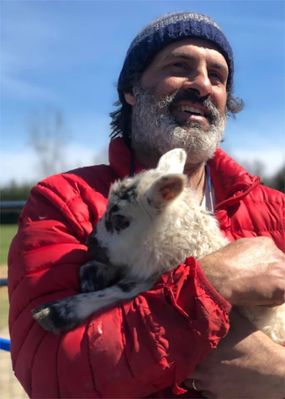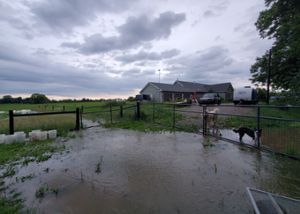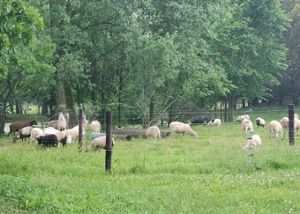New statistical model throws weight behind sustainable farming practices
Driving through the Midwest is often accompanied by the familiar rhythm of cornfield after cornfield. In fact, U.S. farmers planted 69 million football fields of corn in 2019, according to the U.S. Department of Agriculture. But North America’s breadbasket is already taking hits from climate change on several fronts—an entire years’ worth of time and labor can be lost to hail, flood, fire, cold or drought—and the blows are becoming more frequent and unpredictable.
That’s why scientists from Michigan State University and the University of California, Berkeley, are developing a novel statistical model showing that complex crop rotations build ecological and economic resiliency, literally from the ground up, and that lenders can bank on it.

“We want to show that soil health, specifically the practice of higher complexity crop rotations, will work systemically to improve resiliency on a farm,” explained Frederi Viens, professor in the Department of Statistics and Probability in the College of Natural Science. “The model will be able to predict the future of sustainable farming practices as more resilient to climate variability in the medium term, and more profitable in the long-term, than the standard corn/soy rotation, giving lenders the proof they need to support farmers working to build healthy soils.”
Land Core, a nonprofit that works to advance soil health policies and programs that create value for farmers, businesses and communities, is partnering with Compeer, the third largest farm credit cooperative in the country, to support development of the first-of-its-kind model.
Viens is a member of the Land Core Risk Model working group that will use remote-sensed data, soil samples, farmer surveys and sophisticated statistical analyses to convince lenders that prioritizing financing to farmers that adopt practices such as cover crops, no-till, low-till and diverse crop rotations is not a gamble.
“When farmers operate on healthier soils, we should be able to offer those farmers preferential credit rates and terms and lower crop insurance premiums, since our model will show their risk will be lower,” explained Viens, who works with numbers and the land. He and his wife Carolyn Johnston, assistant professor of history at MSU, farm 80 acres of hay and pasture along with over 200 sheep in Laingsburg, Mich., 30 minutes northeast of MSU. “Our model will help insurance agencies and farm lenders understand how practices that improve soil health provide more resilience both to extreme climate events and to run-of-the-mill scenarios that are increasing in frequency under climate change, like being too wet in the spring to plant on time.”

Most farmers depend on the U.S. Farm Bills for loans and insurance to finance their operations. The amount of taxpayer money that foots the bill totaled $28 billion for 2019 and 2020, but most of this money goes to farmers who grow corn and soybeans year after year, Viens explained, and this has consequences for the environment. Monocropping requires increased use of fossil-fuel-based chemical fertilizers, adding to unsustainable greenhouse gas emissions and nutrient runoff.
In contrast, ecological and sustainable farming methods like diverse crop rotations are one of the best buffers to the unpredictability of climate change, something MSU’s Kellogg Biological Station has shown in its long-term field studies. These methods increase crop resilience, sequester carbon, hold more water during a drought and resist runoff during heavy rains.
But switching to these practices, and seeing the benefits, takes an average of ten years, not to mention the cost of new equipment and the risk of failure. Farmers need more than just data to adopt needed operational changes, they need financial support.
Working closely with Timothy Bowles, a prominent agroecologist from the University of California, Berkeley, Viens and his Ph.D. student, Sarah Manski, began building the risk model this summer. The right tools for the job were already at their fingertips—an index of crop rotation complexity developed by Bowles and his Ph.D. student, Yvonne Socolar, along with variables indicating the health of the soil based on crop rotations thanks to remote-sensing satellite technology.
“Using classical and Bayesian predictive statistical methodologies based on probability modeling, we will extract information from the rich datasets on farming practices and soil properties to which we have access, along with fine-scale environmental data,” said Viens, who also directs MSU’s Actuarial Science Program.

Compeer’s pioneering efforts to help create the model that will provide incentive options to farmers who practice sustainable methods will finally make farming for soil health feasible for farmers, profitable for lenders and better for the environment—what Viens calls a win, win, win.
"As a statistician working on agroecological questions, with a background in quantitative finance and insurance, I am delighted to get deep into the data with Land Core and Compeer, to propose and test predictive probability models,” Viens said. “I expect we will show how longer-term, farm-level risk analyses strongly favor solutions which are good for the planet, good for the farmers' pocketbooks and good for the lenders' bottom lines."
To learn more about the pioneering project, please visit: https://landcore.org/news-post/2021/6/1/compeer-financial-joins-land-core-risk-model-initiative.
Banner image: Farm animals graze in winter on a stockpiled cover crop at the farm of Frederi Viens, an MSU professor in the Department of Statistics and Probability in the College of Natural Science, who is working with researchers from the University of California, Berkeley, to develop a statistical model that predicts the resiliency of sustainable farming practices like this. Credit: Frederi Viens